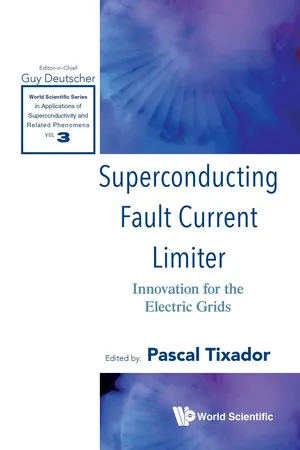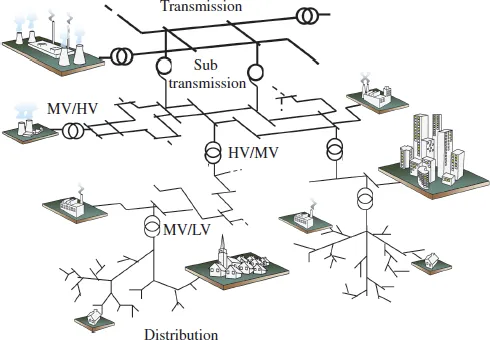
This is a test
- 408 pages
- English
- ePUB (mobile friendly)
- Available on iOS & Android
eBook - ePub
Book details
Book preview
Table of contents
Citations
About This Book
This book mainly deals with SuperConducting Fault Current Limiter (SCFCL), mainly the resistive SCFCLs. It aims to further disseminate the technical knowledge of SCFCL in particular to electrical engineers. The SCFCL is a new component and tool to better design and to be used in existing and future electric grids, altering the conventional way of thinking and planning.
Contents:
- Environment of the SCFCL: The Electric Grid
- Superconductivity and FCL
- AC Losses in SCFCL
- Superconducting materials for SCFCL
- Superconducting Fault Current Limiter
- Resistive SCFCL
- Modeling Resistive SCFCL in Power System Transient Simulators
- Electric Isolation in Cryogenic Environment
- Cryogenics
- Major SCFCL Locations with Reliability and Economic Aspects
- Nexans SCFCL Realizations
- The First Italian SCFCL
- SCFCL Developments at Innopower
- Status of Development and Demonstration of SCFCLs in Korea
- Introduction of SCFCL 220 kV in Moscow Energy Grid
- Accelerating Quench Propagation in 2G HTS Coated Conductors by Engineering the Tape Architecture
- Some New Developments — Sapphire Substrate
Readership: Graduate students, post-docs and colleagues working in the field of superconductivity.
Key Features:
- It is the only book dedicated to the SCFCL with all the aspects from material to cryogenics and model for the grid
Frequently asked questions
At the moment all of our mobile-responsive ePub books are available to download via the app. Most of our PDFs are also available to download and we're working on making the final remaining ones downloadable now. Learn more here.
Both plans give you full access to the library and all of Perlego’s features. The only differences are the price and subscription period: With the annual plan you’ll save around 30% compared to 12 months on the monthly plan.
We are an online textbook subscription service, where you can get access to an entire online library for less than the price of a single book per month. With over 1 million books across 1000+ topics, we’ve got you covered! Learn more here.
Look out for the read-aloud symbol on your next book to see if you can listen to it. The read-aloud tool reads text aloud for you, highlighting the text as it is being read. You can pause it, speed it up and slow it down. Learn more here.
Yes, you can access Superconducting Fault Current Limiter by Pascal Tixador in PDF and/or ePUB format, as well as other popular books in Technology & Engineering & Electrical Engineering & Telecommunications. We have over one million books available in our catalogue for you to explore.
Information
Chapter 1
Environment of the SFCL: The Electric Grid
In this chapter, we will address the structure of the electrical grid. An emphasis will be stressed on the effects of failure on the stability and security of the grid. The recourse to superconducting fault current limiter (SFCL) could be interesting to help the management of the network in case of failure. We will also address new trends in the electrical industry that would be an opportunity to use SFCL.
1. Introduction
The electrical grid is generally an interconnected network for achieving electricity from suppliers to customers. It consists of generating stations, high voltage transmission lines and distribution lines that connect to individual customers.
Since the industrial ages, the electrical grid has evolved from an isolated system that fed a dedicated area to a wider and expansive network that makes it possible to take advantages of economies of scale and to use centralized power generation stations.
Electric utilities across regions are often interconnected to ensure continuing and reliable power. But a large failure in one part of an interconnected network could cause the current to re-route, exceeding the allowed current of some remaining lines, causing further failures, leading to a complete power outage (blackout). One benefit of using the SFCL is to limit the increase of the current linked to the fault and associated events.
Besides, new trends in the electrical industry have appeared. Let us quote, for instance, the use of distributed generation facilities that will smoothen the differences between transmission and distribution networks (and therefore also concerning the management of failures).
The development of the “smart grids” will require, for instance, a high level of flexibility for the network. This could be achieved through the use of SFCL as we will explain latter. Finally, the future development of the supergrids (meshed HVDC networks) will also be an opportunity to take benefit using SFCL as we will also explain further.
2. The Power Grid: Specifications and Requirements
Electrical grids can be considered as a critical infrastructure. The lack of efficient and sufficient strong facilities close to each load mostly explains the interconnected structure of a power grid. The scale of this interconnection overpasses the border of a country: the example of the UCTE shows that the management of the power grid must be undertaken at a very large scale and also addresses a very complex and intricated structure.
A power grid is generally composed of many layers. Each layer has a given role to play in the operation of the grid. The associated philosophy is different.
The electrical grid is mainly meshed conceived. For the operation of the grid, depending on the voltage level, the meshed structure is either kept or discarded.
The transmission grid covers a wide area and great lengths. It aims at transferring the power among the territory and also to the neighboring countries. It can be considered as the backbone of the grid. Therefore, it is mandatory to ensure its security. This is the reason why its structure is meshed and its management is based on the N-1 rule (the security is assured even if a device of the grid is missing due to an outage for maintenance purposes) (see Figure 1).

Figure 1.Structures of power grids.
The distribution grid is fed by the transmission grid and aims at distributing the power to the loads. These grids are generally meshed conceived but are radially operated. It means that the loss of equipment cannot be compensated so easily as for a transmission grid: a power cut may be practiced to change the configuration of the feeder and to feed once again the maximal number of loads.1
Besides the need for security, power quality and availability lead to a high level of dependability from electricity and events that can cause power cuts must be avoided or at least damped or isolated.2
The power grid has to ensure the balance between production and consumption (including also the technical power losses). This balance must be ensured at each instance: a deviation will lead to the trip of equipment and, if nothing is done, to a total collapse of the grid called blackout. Figure 2 depicts the behavior of the frequency and the power balance in Italy just before the blackout on 28 September 2013. As it can be noticed, the grid operator has a very short time to react before the blackout occurs.

Figure 2.Frequency and power deviations during the event of 28 September 2013.
These deviations could be associated to various events such as huge increase of load, lightning stroke, storms, equipment outage, and external outages leading to short-circuit.
New production means (dispersed generators (DG) such as wind generators) and non-conventional loads (such as electrical vehicles) connected to the grid bring more intermittent power and therefore add the complexity of the management and the operation of the grid.
By this way, the grid must be more and more flexible in terms of architecture; the increased generator power and size provide an increased short-circuit power. It is therefore mandatory to develop protection systems to eliminate the faults and/or to damp the propagation of the fault throughout the entire grid.
3. Faults Inside a Grid
3.1. What can be considered as a fault?
Among the various events that can be encountered inside a grid, faults are the most critical ones because their consequence could be a total collapse of the grid. Here are some other unexpected events for the grid.
At a private person’s house, this happens when two metallic masses at different potentials, two metallic wires for example, touch together fortuitously. A spark flashes, and the circuit breaker of the house opens — or a fuse melts — under the effect of a too high current.
On a high voltage overhead line, it is quite different: indeed, it is not necessary that two conductors touch each other to make a spark flash. It is enough that both conductors be sufficiently close to one another. An arc appears, the air becomes ionized along the route of this arc and becomes conducting. It remains so until the voltage is entirely suppressed.
The ignition distance between two conducting objects depends on the voltage, the form of the objects (point effect), and the moisture and pressure of th...
Table of contents
- Cover
- Halftitle
- Series
- Title
- Copyright
- Foreword
- Preface
- Contents
- Chapter 1. Environment of the SFCL: The Electric Grid
- Chapter 2. Superconductivity and FCL
- Chapter 3. AC Losses in Superconducting Fault Current Limiters
- Chapter 4. Superconducting Materials for SFCL
- Chapter 5. Superconducting Fault Current Limiters
- Chapter 6. Resistive SFCL Design
- Chapter 7. Modeling Resistive Superconducting Fault Current Limiters in Power System Transient Simulators
- Chapter 8. Electrical Insulation in Cryogenic Environment
- Chapter 9. Cryogenics
- Chapter 10. Major SFCL Locations with Economical Aspects
- Chapter 11. SFCL Developments at Nexans
- Chapter 12. The First Italian SFCL: From Design to Live-Grid Testing Activity and Effective Current Limitation of A Severe Three-Phase Short-Circuit
- Chapter 13. SFCL Developments at Innopower
- Chapter 14. Status of Development and Demonstration of SFCLs in Korea
- Chapter 15. Introduction of SFCL 220 kV in Moscow Energy Grid
- Chapter 16. Accelerating Quench Propagation in 2G HTS, Coated Conductors by Engineering the Tape Architecture
- Chapter 17. Sapphire-Based SFCL Conductors
- Conclusions
- Index